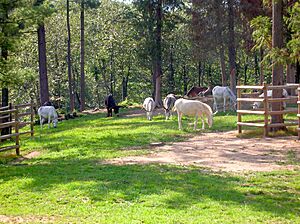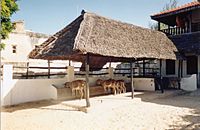The Donkey Sanctuary facts for kids
The Donkey Sanctuary is a special charity in Britain that helps donkeys. It is based near Sidmouth in Devon, England. This amazing organization was started in 1969. It is one of the biggest charities in the world that helps animals like donkeys and horses. They spend a lot of money each year to care for these animals.
Contents
How The Donkey Sanctuary Started
The Donkey Sanctuary was founded in 1969 by a kind woman named Elisabeth Svendsen. It officially became a charity in 1973.
Elisabeth's Inspiration
Elisabeth decided to start the sanctuary after visiting a market in Exeter. There, she saw seven small donkeys squeezed into a tiny pen. This made her realize how much these animals needed help.
Growing the Sanctuary
By 1973, Elisabeth was already looking after 38 donkeys. A year later, in June 1974, she received a surprising phone call. She learned that another donkey sanctuary, run by Miss Violet Philpin, had left 204 donkeys to her care!
After getting permission from the UK Charity Commission, Elisabeth's charity merged with Violet Philpin's. The Donkey Sanctuary then bought Slade House Farm near Sidmouth. Since then, over 14,500 donkeys have found help at the sanctuary in the UK and Ireland.
Reaching Out
The charity now works in the UK, Ireland, and other parts of Europe. They also have projects in Africa and Asia. In 1980, Elisabeth Svendsen was given an award called an MBE for all her hard work helping animals.
In 2011, Elisabeth Svendsen, the founder of The Donkey Sanctuary, passed away at 81 years old. The charity continues its important work, managed by a group of seven trustees.
Helping Donkeys Around the World
The Donkey Sanctuary provides a safe, permanent home for more than 4,000 donkeys.
In Europe
Today, the sanctuary has homes and foster places in nine European countries. These include the United Kingdom, Ireland, Cyprus, France, Greece, Italy, Portugal, Romania, and Spain.
Many donkeys come to the charity because they have been neglected or are no longer wanted. Others are given to the sanctuary because their owners can no longer care for them. Over 40 welfare officers offer advice to donkey owners across the UK. They also check on working donkeys and investigate reports of cruelty. The charity even holds a yearly competition to find the best beach donkeys! In 2009, the town of Filey won this award.
Around the Globe
The sanctuary runs big projects in countries like Egypt, Ethiopia, India, Kenya, and Mexico. They offer free mobile veterinary clinics and teach donkey owners, children, and veterinary surgeons. By funding local teams, the charity gives over 300,000 treatments to working donkeys every year.
When donkeys visit a mobile clinic, they get a full health check. Their teeth and hooves are cared for, and any wounds are treated. Owners also receive free advice. These clinics have all the supplies needed to treat most donkeys right there.
Common problems for donkeys at the clinics include tiredness, not enough food, and issues with their teeth and feet. Donkeys might also have worms or lice, or open wounds from bad harnesses or whipping. Injuries from road accidents are also becoming more common. In some areas, young foals can get serious wounds from packs of dogs or hyenas. The Donkey Sanctuary helps in remote areas of Egypt, Ethiopia, India, Kenya, and Mexico where many donkeys live.
Learning About Donkeys
The charity helps train vets and animal health assistants in different countries. This improves the care donkeys receive.
Their book, The Professional Handbook of the Donkey, is sent to vets worldwide. Teams overseas have also created a fun education program for children. It includes puppet shows, talks, and storybooks. This program teaches kids about how to care for donkeys properly.
Donkey Assisted Activities
In 1989, a special trust was set up to help children with special needs. It allowed them to have fuller lives by spending time with donkeys. In August 2012, this trust joined with The Donkey Sanctuary. This helped the charity offer more services and save on costs.
Now, the charity calls these programs Donkey Assisted Activities (DAA). They include programs like Donkey Facilitated Learning and Wellbeing With Donkeys. These activities happen at the sanctuary in Sidmouth, Devon. They help many different people, including those with dementia and armed forces veterans.
Visiting Slade House Farm
The main home of The Donkey Sanctuary in Devon is open to visitors every day of the year. You can visit from 9:00 AM until dusk, and there is no charge for entry or parking. The charity estimates that over 200,000 people visited the farm in 2009.
Donkeys of all ages live at the farm. Many older donkeys stay there so they can be close to the veterinary hospital. In 2009, a film called The Donkey Sanctuary, 40 years on... was made about the charity. Elisabeth Svendsen narrated the film herself.
See also
- The Donkey Sanctuary of Canada




